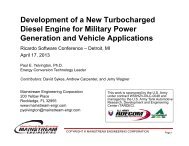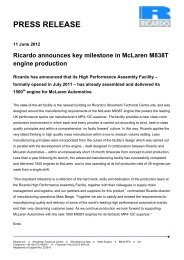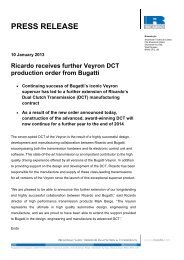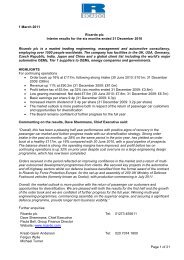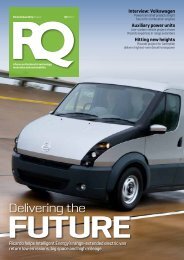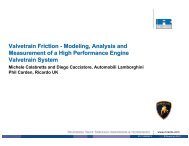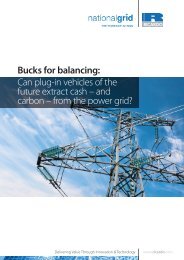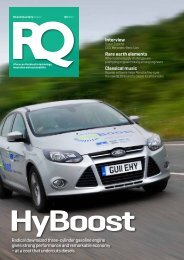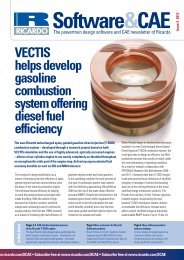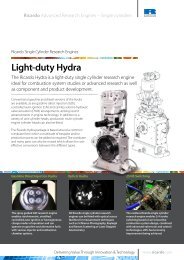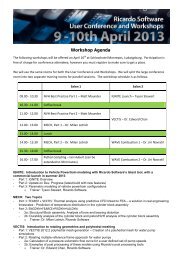The hottest - Ricardo
The hottest - Ricardo
The hottest - Ricardo
You also want an ePaper? Increase the reach of your titles
YUMPU automatically turns print PDFs into web optimized ePapers that Google loves.
Audi use of WAVE<br />
and post-processing capabilities.<br />
Claus Freytag is responsible at Audi<br />
for all acoustic gas dynamic modelling<br />
using 1D simulation methods and, as<br />
a long-time WAVE user, he is very<br />
familiar with the application of the<br />
code to both performance and<br />
acoustic modelling. While Freytag has<br />
full time responsibility for the<br />
application of 1D simulation, his four<br />
colleagues engaged in WAVE<br />
simulation work each focus on a single<br />
vehicle platform – A3, A4, A6 and A8 –<br />
doing both simulation work and<br />
prototype hardware testing. At the<br />
<strong>Ricardo</strong> Software European User<br />
Conference in Frankfurt in December<br />
2005 Freytag presented a case study<br />
of the detailed tradeoffs required in<br />
the development of an exhaust system<br />
for a modern, luxury production<br />
vehicle. <strong>The</strong> example chosen was the<br />
widely acclaimed Audi A8, powered by<br />
the 3.2-litre FSI direct injection V6<br />
gasoline engine, which was launched<br />
in Europe earlier in the year.<br />
<strong>The</strong> start point for the work was an<br />
initial baseline design of exhaust<br />
system represented by a carry-over of<br />
that used for the V6 3.0l MPI unit due<br />
to be phased out in favour of the new<br />
engine. <strong>The</strong> primary objectives set by<br />
Audi for this work were that the new<br />
exhaust system should deliver invehicle<br />
performance and orifice noise<br />
equal to or better than that of the<br />
same engine in the A6 vehicle. It<br />
should also have a similar cost to<br />
existing production and, crucially for<br />
such a luxury vehicle, it needed to<br />
have a noise quality both sporty and<br />
luxurious in character.<br />
Baseline configuration<br />
<strong>The</strong> baseline system configuration had<br />
two branches throughout (each<br />
equipped with close-coupled catalysts),<br />
with forward, middle and rear mufflers<br />
connected via a bridge piece<br />
immediately upstream of the middle<br />
muffler. As the baseline design had<br />
been produced for an entirely different<br />
engine it was perhaps unsurprising that<br />
initial assessment showed it to fall<br />
short of the design objectives in terms<br />
of both torque (-27 Nm) and boom<br />
noise (+8 dB(A)) at 1200 rev/min. As<br />
hardware was readily available, WAVE<br />
simulation was compared with<br />
dynamometer testing of the baseline<br />
design for this first iteration in order to<br />
demonstrate the fidelity of the<br />
analytical model. Correlation was good,<br />
with a comparable figure of torque<br />
reduction in the critical boom noise<br />
region of -23 Nm.<br />
Using the acoustic mode shape<br />
analysis facility in WAVE, the nature of<br />
the noise problem was quickly<br />
identified as excitation of the<br />
characteristic three-quarter<br />
wavelength mode of the complete<br />
exhaust system. In normal<br />
circumstances the most obvious<br />
approach to mitigate such a problem<br />
would be to add volume in the high<br />
pressure regions. However, as this<br />
was a new exhaust system for an<br />
existing vehicle model, there was<br />
limited space available for such design<br />
changes. Instead, the team quickly<br />
identified that optimisation of the<br />
system would need to be restricted to<br />
changes largely within the existing<br />
envelope of the front, middle and rear<br />
muffler sets, and the bridge<br />
connecting the two branches of the<br />
system.<br />
20 RICARDO QUARTERLY REVIEW • Q3, 2006



